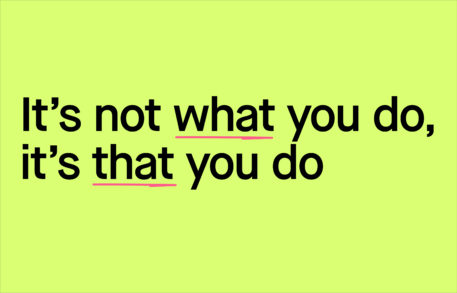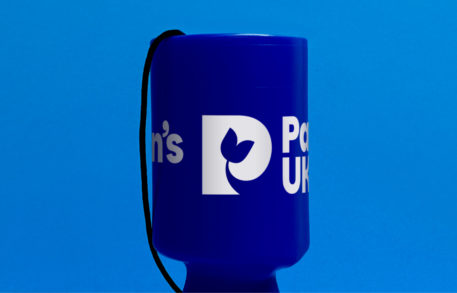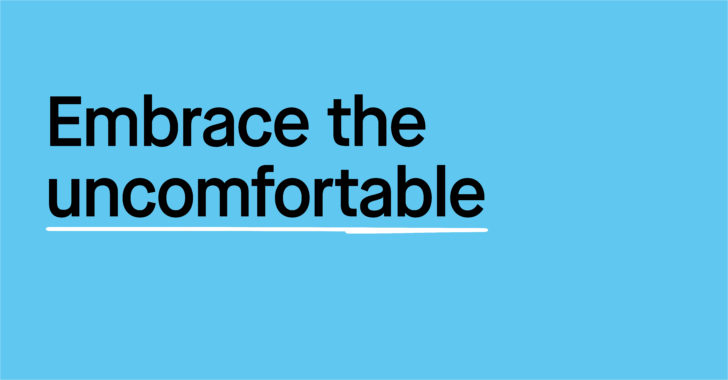
Turning everyone into brand cheerleaders
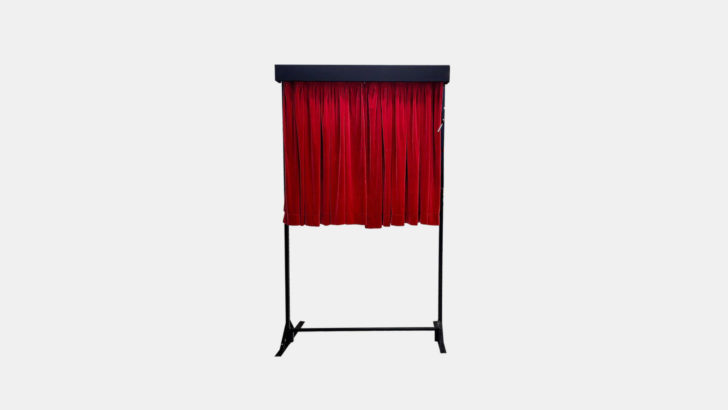
A little bit about launching a brand.
Launching a brand can feel like that big ‘Ta-da!’ moment. Where we finally pull back the curtain and share our work with the world. It’s exciting, but it can also be a little bit scary.
It’s also when we start to relinquish some control over something that we spent months, maybe even years building.
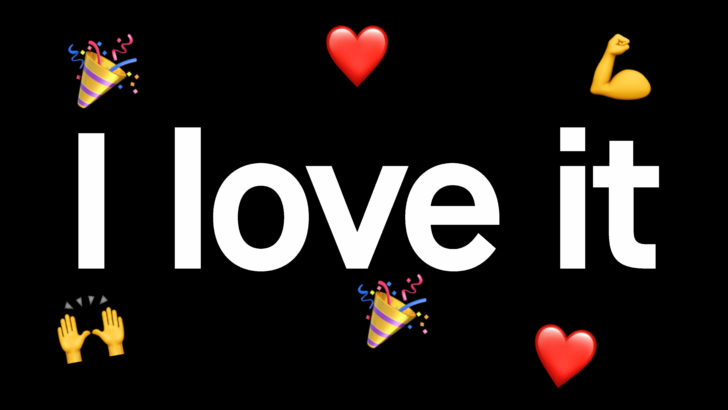
We all hope that we’re going to get a reaction that’s going to be a bit like this. “I love it.”
You know, we want those positive emojis raining down on us. Let's be honest, this is what we’re all here for – to feel that love from across the organisation, and know we can really hit the ground running.
Unfortunately, we usually also get a little bit of “I don’t love it”. Now, a few negative comments are pretty much ‘par for the course’, but it’s quite clear that when we’re handing over a brand to colleagues and internal teams, we’re going to want more of that first group than the second group. These are our brand champions. These are the people who will advocate for the brand.
They’re going to help drive adoption and keep that positive momentum going once the brand launches. But to understanding how we can turn someone into a Brand Champion, we need to understand why they might be a brand critic to begin with.
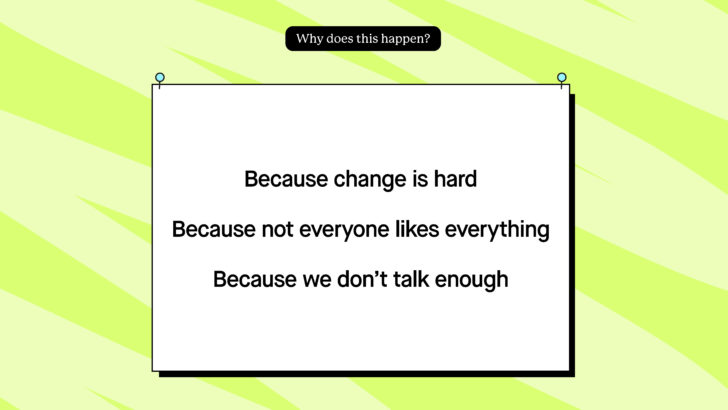
Why does this happen?
So the first reason is simply that change is hard. However, change can be even harder when people feel like it’s being done 'to' them rather than 'with' them.
The second reason is not everyone likes everything. There’s not really a lot we can do about this, but we can be mindful of it as we work through the process.
And the third is because we don’t talk enough. And this is the thing that we want to focus on a little bit today.
Talking (and listening) isn’t always comfortable
Talking and listening isn’t always comfortable. Particularly in a branding project, where we’ve got time constraints and budget constraints, opening ourselves up to constant, difficult conversations and multiple viewpoints can feel like it might derail the project, or at the very least dilute the output. So it’s natural to feel like it might be easier for us to sidestep some of these. But in branding, talking really is essential to bring as many people with us as possible and creating less brand critics and more of those brand champions.
Now, taking this approach isn’t always easy, but it is worthwhile, even though it inevitably involves embracing the uncomfortable.

Why embracing the uncomfortable matters
The first reason is because brand affects and needs everyone. It’s not just about the brand and marketing team. Everyone across the organisation is interacting with the brand every day, so it’s only right that their voices are heard. But also the brand needs everyone. Everyone is going to bring a unique perspective on what their own needs are, what their team needs and what’s going to resonate with their audience.
The second point is that we probably just know a little bit less than we think. It's really easy for us to come in with our brand heads on and feel like we know exactly what’s going to make a brand thrive. The reality is we’ve probably got more than a few knowledge gaps, and other people can help us fill those gaps.
And the third point is that our work isn’t done at launch. So, the branding process is obviously really important, but when we finally launch, that is day one of the brand out in the real world, and that’s when we can really start to bring it to life. And this is also when our brand champions become so important, because they’re the ones that need to pick up the baton and help us keep the momentum built in the brand development process going.
Champions assemble
Building the brand champion group(s)
So, how can we start to assemble our brand champions and how do we build brand champion groups? While we might be led by the brand and marketing team, we can’t only rely on them, or we’re probably not going to end up creating a brand that’s really going to support everyone’s needs.
So when we’re building out that Brand Champion group, we try and look at it from top to bottom and from side to side. Top to bottom means trying to involve people from SLT all the way down to the most junior members of the team and side to side means engaging people from across teams as well. So everyone from HR, digital fundraising, CFOs, the board, we want to welcome as many different viewpoints as possible.
Now that is where we want to pick people from, but we also want to consider the type of person that we should bring into the group. It's sort of tempting to hear the term 'champion' and think, yes, okay, we’re going to get the people who love the brand. The people who are going to bang our drum and cheer us on from the sidelines. Don't get me wrong, these people are great, and we definitely want them in our corner, but they’re probably going to do that regardless.
So from a Brand Champion perspective, we don’t only want to have those people. And actually, sometimes it can be more useful to focus on the slightly more skeptical people in the room. These might be the people who don’t necessarily see the value in brand so much, or have possibly had a bad experience with brand in the past. The type of people who might say something like 'One does not simply swap out the hex codes'.
This is not a verbatim quote from a project, but over the years, we have had similar conversations with people who haven’t felt fully invested in the process, and these are the people that we really want to engage. These are the people who are going to ultimately make the best Brand Champions. But to do that, we need to build understanding and we need to build trust. We need to show them the value in the process and how it the outcome will ultimately have a positive impact on their work.
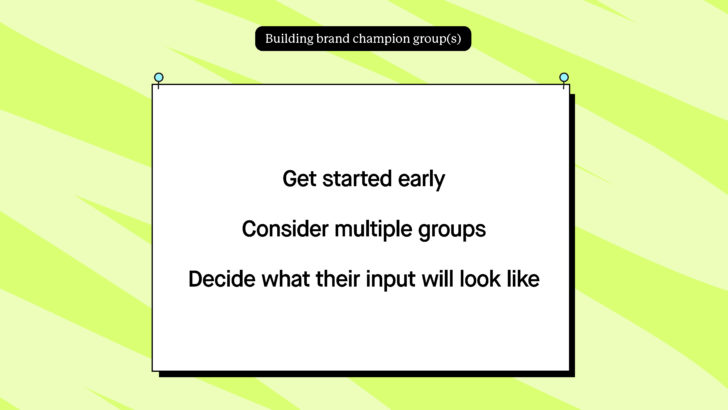
So how do we get there? Get started early. Ideally, this should be one of the very first things we do at the outset of the project. You also might want to consider multiple groups, so in addition to our core Brand Champion group, something like a board sub-committee can be really useful, if you have board sign-off as part of your process – it’s a really good way to engage them in a much more meaningful way.
And then finally deciding what your Brand Champions input is going to look like, what key milestones they need to be involved in and what the feedback process looks like for them and for you.
Set the tone
Keep things clear and open
Then we can start to get into it. And we want to start by talking about setting the tone. This is really about us creating a clear and open space for people. We want people to feel comfortable sharing with us, whether that’s critical views or positive views. This is all about us being able to embrace the uncomfortable.
We find discovery can be a really good opportunity to get the ball rolling here, as we did through our brand development work with Parkinson’s UK.
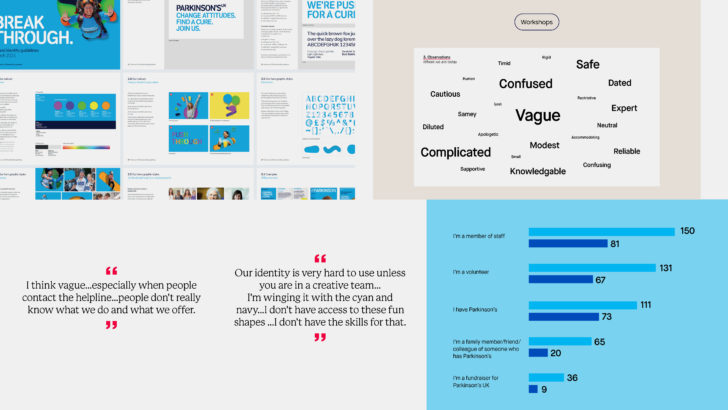
We ran a really in depth discovery process. We ran workshops, interviews, really kind of breaking down where the existing brand was and inviting as many different opinions as possible. And again, this is about us understanding the brand and gathering information.
But it’s also really useful for our brand Champion groups to understand how that process is going to work, and trying to set the stage for collaboration, rather than us trying to sell them something.
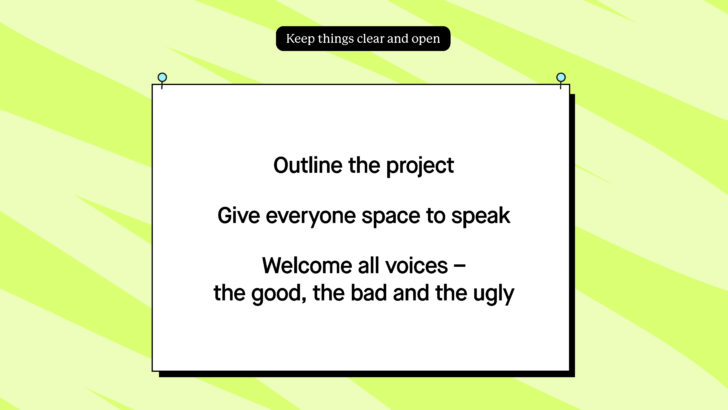
So keep things clear and open and outline the project at the beginning. Why are we doing this? How’s it likely to affect people’s day to day? It's also really important that we give everyone space to speak. So not everybody is going to feel comfortable and confident speaking out in a large meeting, but they might still have really useful, really strong views that we want to hear. So it’s our job to give everyone an opportunity to feed in.
And the final point here is to welcome all voices. And we really do want the good, the bad and the ugly. This is all about honest and open expression, because ultimately that’s how we’re going to be able to build the trust and understanding we're looking for.
Be ready to pivot
Learning how to read the room
Next is to be ready how to pivot and learning how to read the room. The branding process is notoriously gnarly. We can be going along nicely, everything’s going good, and then suddenly you hit a bit of a roadblock and you have to change direction. It’s sort of inevitable, but what you can do is learn how to pivot, and hopefully learn to see some of those obstacles a little bit earlier.
What we really want to avoid is getting ourselves into a Ross from Friends situation where you need to pivot, but you’re a bit too late, and that sofa is well and truly wedged in the stairwell.
We had a lot of challenges come along on the Parkinson’s UK project, but one in particular that we wanted to talk around was early in the creative development process, where we were trying to define a symbol for the brand.
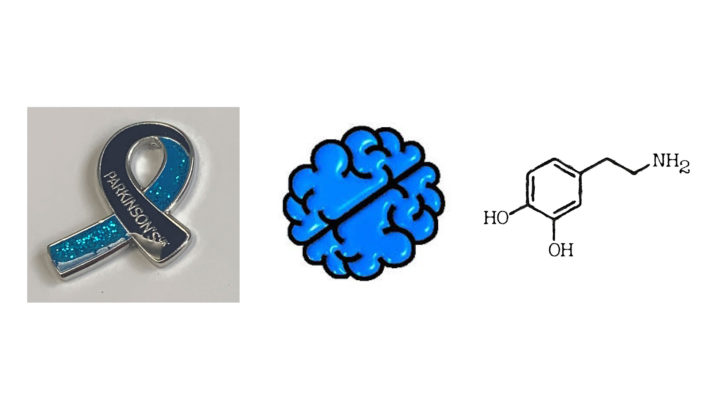
Defining a symbol for a condition as diverse as Parkinson’s is not an easy thing. So we cast a very wide net in our early exploration. This is just three of many, many references that we looked at, but one that resonated quite early on was the idea of the brain. It’s where Parkinson’s originates as a condition, and we felt like it had some real scope for the charity as a symbol.
We’d done some creative development and developed quite an bold, abstract mark that was getting quite a lot of love for from different parties – both within the Brand Champion group as well as in the studio. But we were also increasingly getting some quite strong negative comments from some parts of our Brand Champion group. And the reason we felt so inclined to take these particularly seriously, was where they were coming from.
Some of these voices were coming directly from the community – people living with Parkinson’s. This was such a key driver for this piece of work, to create a brand that people really felt they could buy into and that people living with Parkinson’s could feel some ownership over and feel that it represented them. So it was really critical that no matter how bold and brave we felt this mark was, if it wasn’t going to resonate with that audience, we really needed to act.
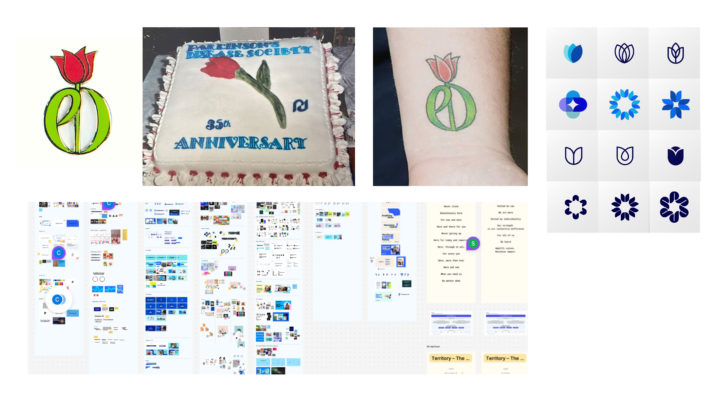
Luckily, we still had another concept in the mix at that point, built around the idea of the tulip. So the tulip is an internationally recognised symbol for Parkinson’s, and we’d already done some discovery around the viability of using that for a mark, and had undertaken some creative concept generation, trying to look at how we could start to bring it to life.
But when we started having those conversations around the brain symbol and those challenges came up, it really helped focus our minds and we realised that we needed to pour our efforts into developing tulip.
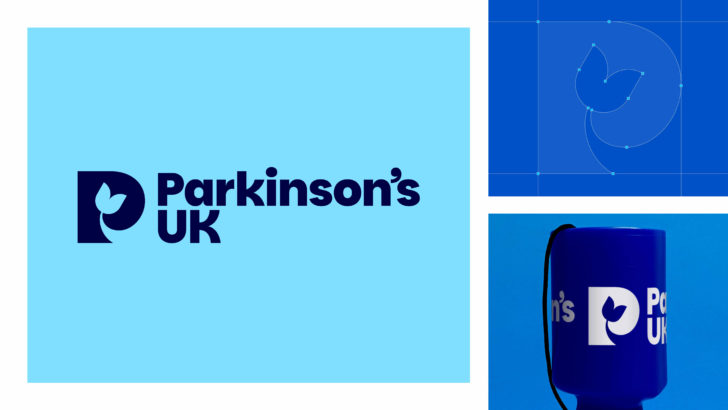
It got much broader approval from our Brand Champion groups, and it definitely felt like a stronger way to go in terms of getting that buy in and that feeling of representation from the community.
So once we did that, we’re able to really focus and build a brand out that was going to both have that bold, brave stance that we knew was needed, but crucially, was going to resonate with our audience. Really listening to negative comments and having those conversations early on meant that we didn’t go too far down a path that just wasn't going to land in the long run.
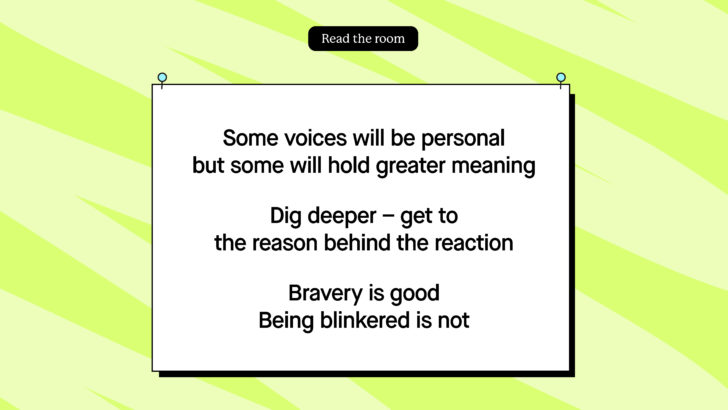
Read the room
So read the room. Some voices will be personal, but some will hold greater meaning, and it’s down to us to dig deeper and to get to the reason behind the reaction. People will comment on things – that’s going to happen time and again, but it’s up to us to unpick that a little bit and understand what’s really behind it.
And always remember, that bravery is really good, but being blinkered isn’t. So in the charity sector today, standing out is sort of more important than ever. We need to be distinctive. So bravery is really something to be cherished and championed. But, bravery can tip over into bloody mindedness, quite easily. And it’s really important that we sometimes step back and think about what we’re doing and whether it’s really going to resonate with our end users. And if it doesn’t, then we might not be on the right path, and it might be time to pivot.
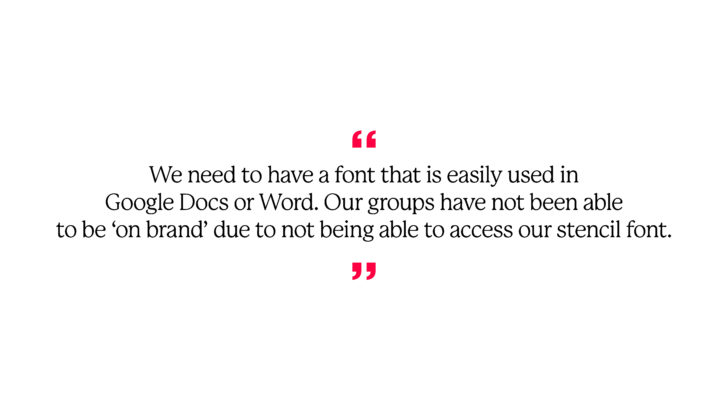
What’s the reality
Understand how the brand will be implemented
The next thing we want to talk about is understanding how a brand is going to be implemented in the real world. Again, one of the biggest strengths of having Brand Champions is that these are the people who are using the brand every day.
They understand how it works and also what its potential limitations and barriers are. So we really need to make sure that we take on board their feedback and feed that into our own creative process. This came up time and again on the Parkinson’s UK project.
The sort of sentiment in the quote above came up a few times during discovery and some of those initial creative discussions, and it was really around the fact that some teams hadn’t been able to sort of access and implement the old brand. That lack of access had really kind of coloured people’s views in terms of how graphic assets, how typography, how these things could work for them, rather than being a kind of barrier to them. So we obviously wanted to take that on board. But also this was a challenge for us, because we were really trying to visually push the brand forwards. We wanted to bring a lot of personality to it, particularly through typography.
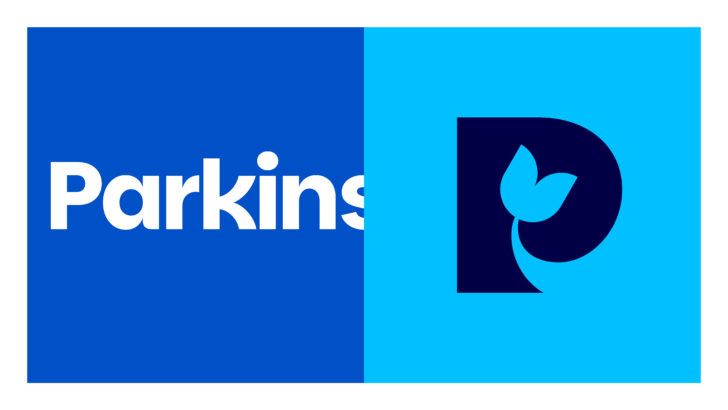
We had pretty much nailed down the tulip symbol at this point, and we wanted to imbue that sense of personality through our typography as well give the brand something much more distinctive and unique. But this challenge for it to accessible to everyone led to a decision that our typeface would have to be something that was available on Google Fonts. No this was obviously a bit of a contradiction. Google Fonts are amazing, but by their very nature, they’re quite ubiquitous, and it’s quite hard to have something distinctive. So we were trying to find ways to sort of square that circle, and eventually we did that by creating a new, bespoke typeface that would be available on Google fonts.
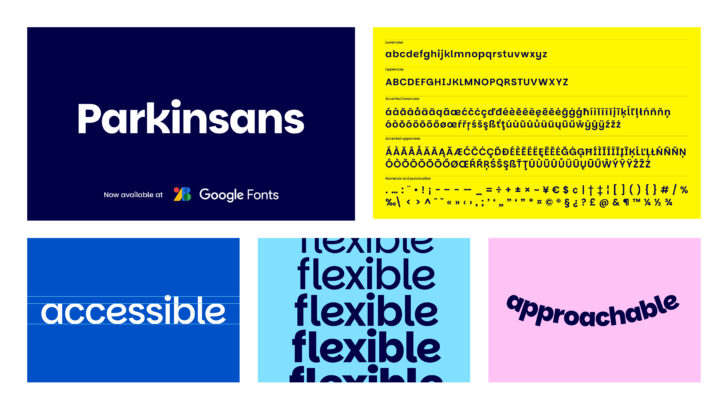
Parkinsans allowed us to have all that personality, all that character and distinction that was so important to the brand, but also be something that was truly accessible, not just accessible in terms of the character structure, but accessible to everyone across the organisation.
For anyone who hasn’t tried to get a font onto Google Fonts, it’s not a particularly easy process, and it does take a lot of commitment from all sides, but it was so worthwhile, and again, coming from that point of understanding how the brand would be implemented, really drove us in a direction, and it became a real virtue of the project and something that could was both instantly recognisable and something that everybody could use.
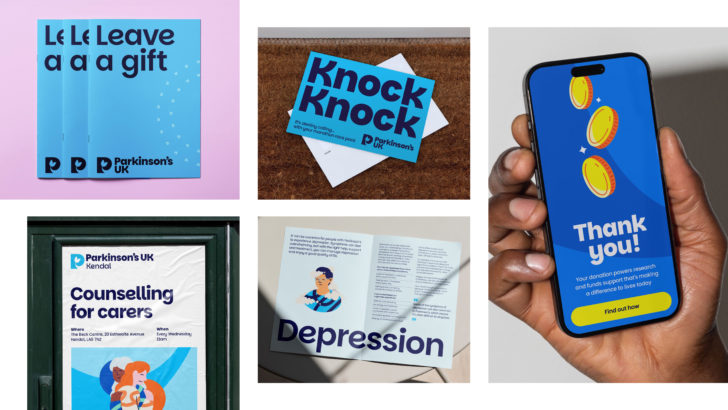
So whether you’re a local volunteer, through to the brand team, the digital team and beyond, this was truly accessible and made it possible for everyone to create on brand materials that have that personality and that visual distinction coming through purely through typography.
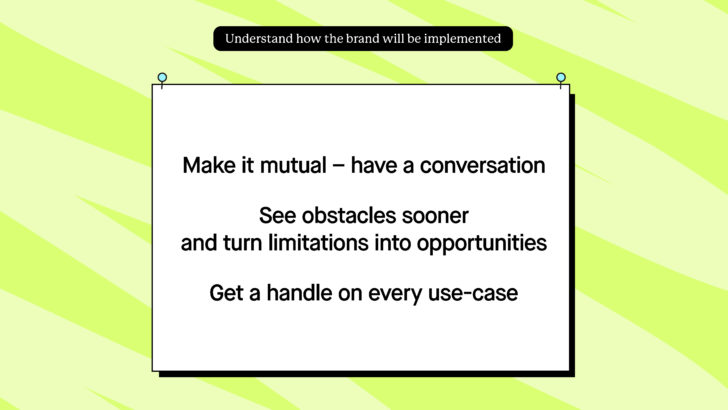
That strength of understanding how a brand is going to be implemented is so important, so try to make things mutual and have a conversation. Understand why people are saying things helps you see potential obstacles sooner, and might allow you to turn a limitation into an opportunity.
And then finally, just get a handle on every use case. So it’s our job to understand the different use cases and understanding that a volunteer is going to be able to use the brand very differently, to the brand team, to an external agency, to how the digital team are going to want to implement it. We need to get sight of all of that and build a system that is going to work for everyone.
It’s about understanding implementation across the board, which leads quite nicely onto my next point, which is about building for everyone, and not just paying lip service.
Build for everyone
Don't just pay lip service
When we invite Brand Champions into the brand development process, we’re explicitly asking them to give feedback. We’re also asking them to give their time and commit to this process.
So we need to make sure that we’re reciprocating that and giving back to them. That means we need to provide that reassurance and understanding that we’re building a brand that is going to work for them, and we’re not just building a brand in a more generic sense.
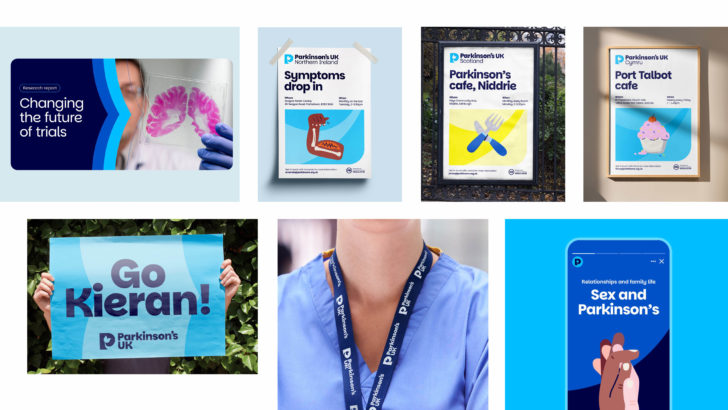
Really stress testing how a brand is going to work for different teams can help bridge gaps with sceptical members of the group, and help build trust that you’re building a brand that is going to work for them. So actively address the needs they have, and really acknowledge their concerns.
So when we went through the development process with Parkinson’s UK, we tried to keep that front of mind at every creative stage. From research, nursing and fundraising, to local volunteer groups and how the brand would show up on social, the new brand needed to work in a lot of different places and spaces. But that time time spent exploring the stretch and strength of the brand to work in these different ways was so valuable in helping build that trust and helping reassure any concerns that came up.
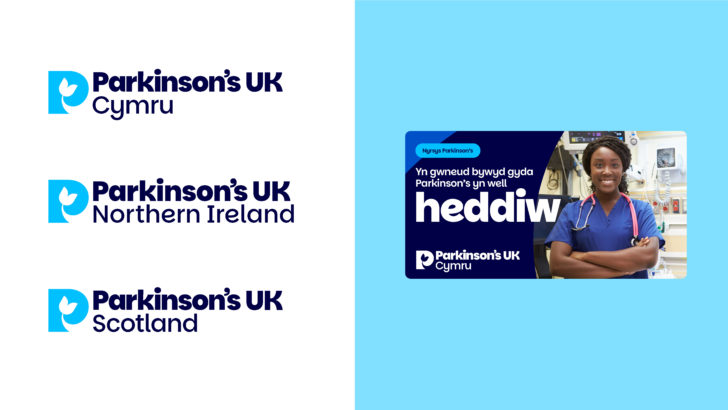
Unique requirements
When it comes to building a brand for everyone, the second point I wanted to make is around any particularly unique requirements that your Brand Champions might have. So with this project, it was particularly important that we were engaging the Parkinson's UK nation’s teams as well, and we weren’t just building a brand for the English team. When it came to Parkinson's UK Cymru, we had the unique challenge of needing to develop something that would work in a bilingual way.
We wanted to make sure we engaged them in the process early on and particularly when it came to something like the strapline, we didn’t just want to have something that sort of went through Google Translate and was technically right. We wanted to consider how the words would flow and how it would be experienced by a native Welsh speaker.
Having those conversations and understanding of how those words would be experienced meant we had to park what we felt were a couple of very strong English straplines, but it was for the good of the project. We were building a brand that was for everyone, not just for our English-speaking colleagues.
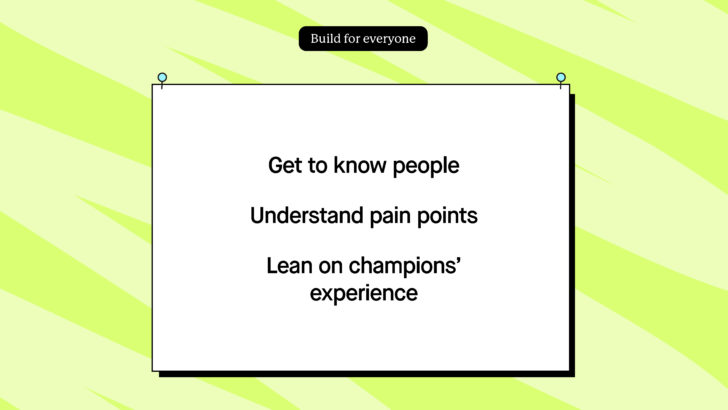
So build for everyone, get to know people and understand their pain points. What is it that’s not working for them, and how can we use brand to make their life easier? And finally, lean on your Champions’ experience so they are going to know more about their area of expertise than you do. That was definitely the case with the Welsh team and it was a really kind of invaluable experience.
Sweat the small stuff
Value every perspective
And finally, sweat the small stuff and value every perspective. In a branding project, you’re going to go down countless cul-de-sacs that can seem very small at the beginning, but can quite quickly balloon into bigger conversations.
These conversations can seem like they’re going to be very time consuming, but while you can’t fix everything, we always recommend trying to take the time to unpack these issues when they come up. Again, this is all about providing reassurance to our Brand Champions. It’s about building that sense of trust and understanding so we can move forward together.
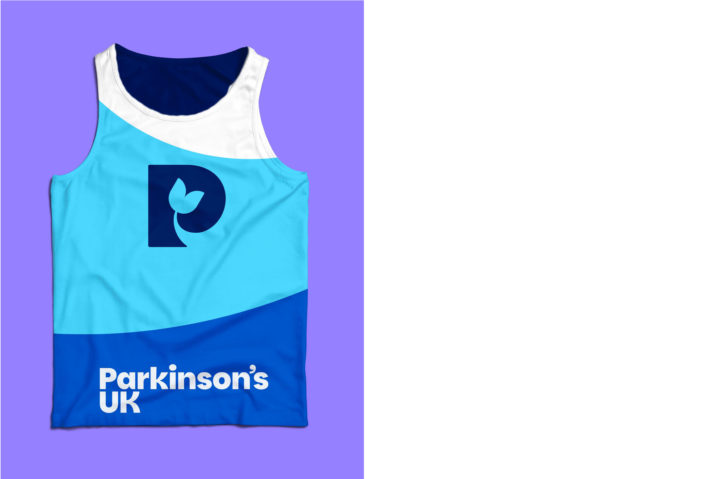
This was one little visual thumbnail on maybe a page of 10 visuals in a deck of maybe 30 pages, just showing how the brand was going to show up across events materials. But when we shared it, we got pulled up by someone from the events team who didn’t feel like it was working. And this was not necessarily a brand thing, per se, but more to do with the technical application of the brand.
We hadn’t necessarily considered in detail how a runners name would going be transferred on and there wasn’t necessarily quite enough space for the race number or maybe the logo might be a bit low. There were basically a few kind of things that for them, meant it just wasn’t working. Now it’d be quite easy for us to say, well, this is a proof of principle thing. It doesn’t have to look like this. It’ll be in the guidelines. Don’t worry about it. But for us, again, it was really important try and provide that reassurance, and to have those conversations and understand their concerns, and understand that we needed to deliver a brand that was going to work for them.
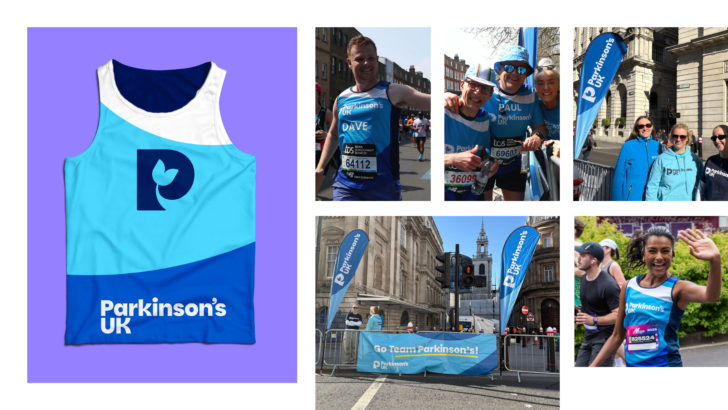
And as a result since the brand has launched, and they've started to roll out their materials, they've started to produce materials that are not only on brand, but really work for them and for their audience.
So value every perspective. Make sure we don’t dismiss objections, but we do grasp the nettle and have those difficult conversations that come up, even though sometimes it would be easier not to.
And finally remember to look at the big picture. So honestly, a brand is probably not going to live and die by a single brand asset, but it can sink or swim based on the buy in of your internal colleagues.
So have conversations, find your critical friends, and try to build that sense of reassurance, that understanding and trust, so that when you launch a brand in the real world, those critical friends can become your biggest champions. And hopefully, if we do a little bit of all of that, we set ourselves up for brand success.
By Red Stone
Presented at CharityComms Brand Breakfast forum
21st May 2025
